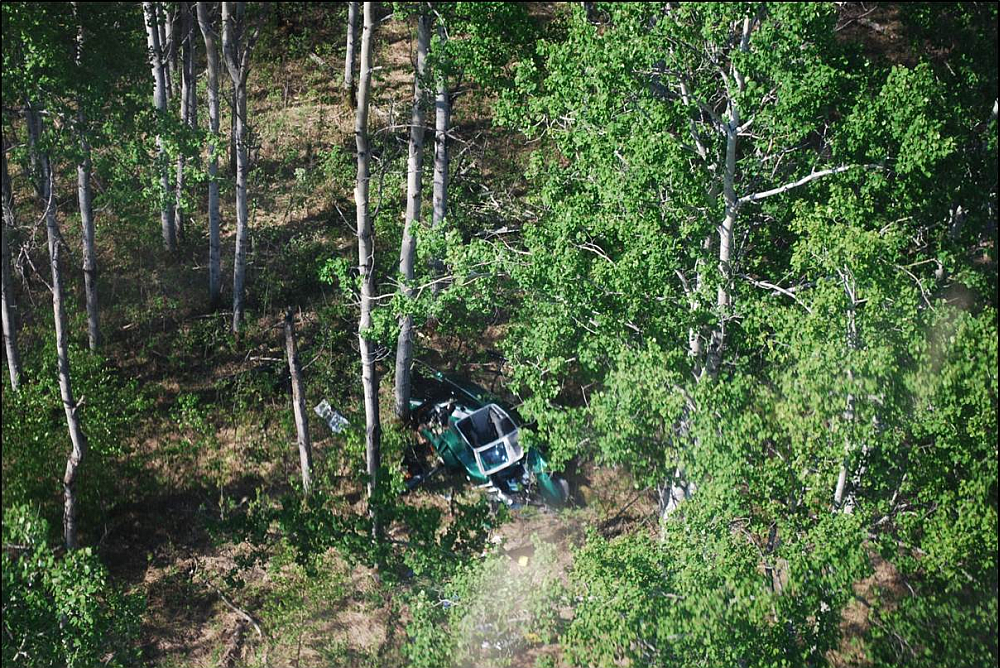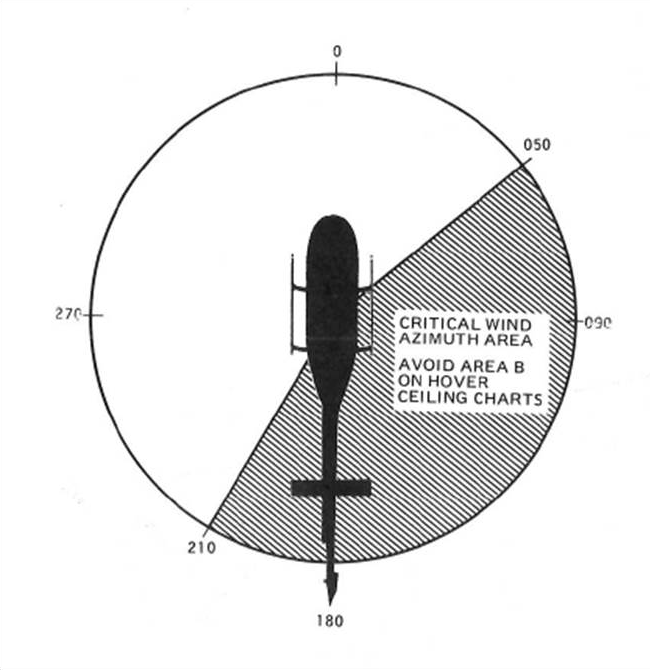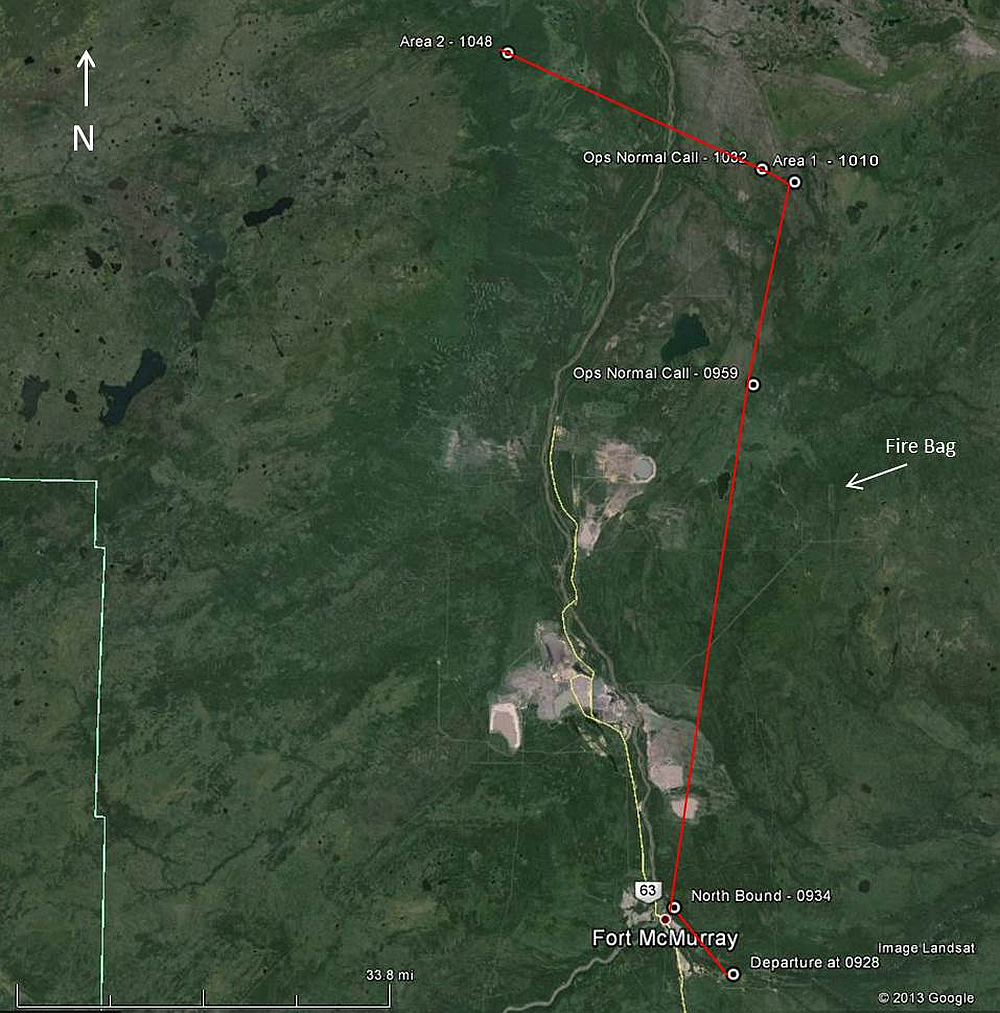Loss of tail rotor effectiveness, and collision with terrain
Aurora Helicopters Ltd. (dba Wood Buffalo Helicopters)
Bell 206B C-FZWB
Fort McMurray, Alberta 75 nm N
The Transportation Safety Board of Canada (TSB) investigated this occurrence for the purpose of advancing transportation safety. It is not the function of the Board to assign fault or determine civil or criminal liability. This report is not created for use in the context of legal, disciplinary or other proceedings. See Ownership and use of content.
Summary
Wood Buffalo Helicopters, Bell 206B helicopter (registration C-FZWB, serial number 1342), was conducting wildlife survey work approximately 75 nautical miles north of Fort McMurray, Alberta. In the course of identifying a landing site, the helicopter entered an un-commanded rotation to the right, and descended into a stand of trees at 1058 Mountain Daylight Time. The pilot and right rear seat passenger sustained fatal injuries. The remaining passenger, who occupied the left front seat, was seriously injured. The 406 MHz emergency locator transmitter activated on impact. There was no post impact fire.
Factual information
History of the flight
The flight was chartered by Alberta Sustainable Resource Development (ASRD) to track discarded caribou radio collars. Two wildlife biologists would use an externally-mounted antenna coupled to a portable receiver to track these collars. Once found, the helicopter would land in the vicinity of the collar, and the biologists would disembark, locate, and retrieve the collar on foot.
Aircraft operating under contract to ASRD are required to maintain a radio watch with the local command and control centre located in Fort McMurray. The pilot made an initial radio check call with the ASRD command centre at 0915.Footnote 1 At 0924, the pilot called in to report that they were departing northbound. The flight departed the Wood Buffalo Helicopters' facility, located at the Fort McMurray Airport, at 0928. As required by ASRD policy, the pilot transmitted a 30-minute position/status call to the ASRD command centre at 0959, reporting that they were north of Fort MacKay/Firebag Aerodrome. The helicopter was at 1340 feet above ground level (agl) with a ground speed of 99 knots (Appendix A).Footnote 2
At 1010, the helicopter entered area 1, where a number of orbits were conducted in order to fix the location of a radio collar. The helicopter flew as low as 100 feet agl, but did not land in the area. The ASRD command centre attempted radio contact at 1029 with no response. The pilot did check in at 1032 indicating that operations were normal and that they were proceeding to the second site to the northwest. At that time, the helicopter was at an altitude of 550 feet agl and at a groundspeed of 58 knots.
At 1048, the helicopter arrived in the vicinity of area 2. The next 8 minutes were spent orbiting the area to fix the radio collar's location and assessing a suitable landing zone.
At 1055, the helicopter orbited the area and executed a wide left-hand turn at 140 feet agl. At 1056:14, the helicopter turned eastbound at 120 feet agl at a ground speed of 36 knots. At 1056:24, the helicopter was at 105 feet agl at a ground speed of 27 knots. The wind component at this time would have been predominantly a left crosswind from the north at approximately 5 knots.
At 1056:34, the helicopter was at 115 feet agl with a ground speed of 16 knots. At this point, a right turn to the south was initiated. The ground speed had reduced to 5 knots. A final global positioning system (GPS) waypoint was recorded at 1056:54 with the aircraft at 18 feet agl with a ground speed of 3 knots. Upon completion of the turn to the south, the helicopter would have been exposed to a tail-wind condition. The helicopter entered an un-commanded rotation to the right. There were no indications of mechanical malfunction prior to or during the rotation. The helicopter descended into a stand of poplar trees 60 to 70 feet tall, coming to rest on its right side.
After ASRD attempted radio contact at 1108, with no response, it received a telephone call from Wood Buffalo Helicopters at 1109 regarding a reported emergency locator transmitter (ELT) signalFootnote 3 for C-FZWB. At 1114, a company helicopter was dispatched to the last known co-ordinates to search for the helicopter, arriving over the site at 1143. It located C-FZWB at 1154. Additional rescue resources arrived on scene to help recover the helicopter's pilot and passengers.
Wreckage examination
Three trees adjacent to the site exhibited damage related to the helicopter's descent through the trees. All 3 showed rotor-blade damage near the tops; 1 tree had been topped and the majority of its branches stripped off.
All of the helicopter's components were identified within a 100-foot radius of the aircraft. The helicopter's cabin and fuselage were in a single piece, but it had sustained substantial impact damage, particularly on the right side of the fuselage. The main rotor head shaft had separated below the rotor head, and was located 26 feet from the wreckage. One main rotor blade had sustained 2 fractures. The other main rotor blade, while still attached to the rotor head, was substantially damaged.
The tail boom was adjacent to the fuselage but it was severed approximately 3 feet aft of the horizontal stabilizers. It had indications that it had struck a tree at that point, on the left side of the tail boom. The remainder of the tail boom, including the vertical fin and tail rotor, was located about 7 feet aft and slightly east of the forward section. The aft section was oriented with the tail cone towards the main wreckage.
The tail rotor was mostly intact with one blade still attached to the yoke. This blade was straight with minor impact damage to the skin. The other blade had fractured just outboard of the yoke, and was lying on the ground approximately 5 feet east of the aft section of tail boom.
The investigation determined that there had been flight control continuity before the accident. Continuity with the engine, transmission, and tail rotor assembly was verified. Damage to the aircraft was consistent with power being produced. Tree impact damage to the main rotor blades was to the under-surface of the blades.
At the time of the occurrence, the pilot was occupying the right front seat, which is the traditional pilot position in helicopters. One passenger was in the right rear seat. Both pilot and the right seat passenger were wearing aviation helmets at the time of the occurrence, and had been secured with the available 4-point harnesses. The surviving passenger, in the left front position, was not wearing a helmet and was using the 4-point harness. This passenger was able to evacuate from the helicopter through the broken front windscreen.
At the time of the occurrence, the helicopter was within the prescribed weightFootnote 4 and balance limits.
Flight crew
Records indicate that the pilot was certified and qualified for the flight in accordance with existing regulations. The pilot held a valid commercial pilot licence – helicopters, endorsed for the Bell 206 helicopter. At the time of the occurrence, the pilot held a valid Category 1 civil aviation medical certificate with no restrictions.
The pilot had begun employment with Wood Buffalo Helicopters on 01 April 2013, and had received ground training—which included awareness of vortex ring state and loss of tail rotor effectiveness,—and flight training on the Bell 206B helicopter. The pilot successfully completed a company-administered pilot proficiency check for the Bell 206B on 14 April 2013.
At the time of the occurrence, the pilot had accumulated approximately 504 hours of flight time on helicopters, 400 hours of which on the Bell 206 helicopter. The pilot was on his 11th consecutive duty day, after having had 8 days off.
The pilot's last days of work consisted of no flying on 26 May, 3.1 hours of flying on 27 May, and 3.0 hours of flying on 28 May. There was no indication that any physiological factors, including fatigue, played a role in the accident.
Aircraft
The helicopter was owned by Wood Buffalo Helicopters and operated under Subpart 702 of the Canadian Aviation Regulations at the time of the occurrence. A review of the helicopter's maintenance records indicated that the helicopter was maintained in accordance with the existing regulations at the time of the occurrence. There were no reported or outstanding defects. The helicopter was not equipped with flight data recorders or cockpit voice recorders nor was it required to be by regulation. It was equipped with a Garmin GPS, which retained track data of the occurrence flight (Appendix A).
Weather
The ASRD produced a weather observation from Birch Mountain, which is located approximately 11 nautical miles south of the accident site. At 1200, the visibility was 19 nautical miles. The temperature was 18°C and the relative humidity was 51%. The density altitude was calculated to be 2198 feet above sea level. The winds were reported to have been from the north at 5 knots; the cloud height was not reported.
A pilot report from the company helicopter, the first on site after the accident, indicated that the sky was clear, winds were light, and the temperature was about 23 to 24°C. No cumulonimbus clouds or adverse weather conditions were observed.
Unanticipated yaw or loss of tail rotor effectiveness
The main rotor blades of the Bell 206B helicopter rotate counter-clockwise when observed from above. As a result of this rotation, the helicopter experiences a torque effect in the opposite direction, which results in the helicopter yawing to the right. To counter this movement, the helicopter is equipped with a tail rotor system. As torque is transmitted through the main rotor system, the pilot is able to counter the resulting yaw with the use of the tail rotor control pedals, which increases or decreases the amount of anti-torque thrust as required.
Loss of tail rotor effectiveness (LTE) is the occurrence of an un-commanded yaw rate that does not subside of its own accord and, which, if not corrected, can result in the loss of the helicopter.Footnote 6 LTE is not related to an equipment or maintenance malfunction, and may occur in all single-rotor helicopters at airspeeds less than 30 knots. It is the result of the tail rotor not providing adequate thrust to maintain directional control, and is usually caused by either certain wind azimuths (directions) while hovering or by an insufficient tail rotor thrust for a given setting at higher density altitudes.
The Bell 206 aircraft flight manual advises caution when operating when the relative wind is within the critical wind azimuth area. The aircraft flight manual goes on to discuss hovering ceilings, and alerts the pilot that when operating within area B,Footnote 7 depicted by the hatched area in Figure 2, tail rotor control margin and/or control of engine temperature may preclude operation in area B of the hover ceiling charts when the relative wind is in the critical wind azimuth area. As a result, there is the potential for a loss of tail rotor effectiveness.
The aircraft flight manual cautions that when operating at low airspeeds above altitudes published in performance charts, tail rotor effectiveness may be marginal at high power settings under these conditions.
Bell Helicopters issued Information Letter 206-84-41 in 1984 identifying low speed flight characteristics that can result in unanticipated right yaw. The Federal Aviation Administration's Advisory Circular 90-95 discusses the phenomenon of unanticipated right yaw and recommends recovery techniques. This article identifies conditions in which LTE may occur, notably “during any maneuver which requires the pilot to operate in a high-power, low-airspeed environment with a left crosswind or tail wind,” especially in right turns. The recommended recovery procedure would require the application of full left pedal, movement of the cyclic forward and, potentially, a reduction in power, if altitude permits.
Transport Canada, in an issue of Aviation Safety VortexFootnote 8 discussed the phenomenon of unanticipated right yaw and recommended recovery procedure.
Transport Canada's Study and Reference Guide: Private and Commercial Pilot Licence (Helicopter)Footnote 9 identifies LTE as a ground school topic to be discussed as part of aircraft performance. Transport Canada's Helicopter Flight Training ManualFootnote 10 makes the following reference to LTE:
In strong gusty wind conditions, a turn away from the into-wind position should be opposite to the torque reaction […]. In this way you will ensure that there is sufficient tail rotor control available. Should control limits be reached at this stage, a safe turn back into wind can be accomplished.
TSB laboratory reports
The following TSB Laboratory report was completed:
- LP 104/2013 - GPS and Annunciator Panel
This report is available from the TSB upon request.
Analysis
The examination of the helicopter as well as the data collected during the investigation indicate there were no mechanical issues that would have resulted in the loss of control and subsequent crash. There was no indication that any physiological factors, including fatigue, played a role in the accident. The analysis will focus, therefore, on the aerodynamic phenomenon known as loss of tail rotor effectiveness (LTE).
The helicopter was operating in a flight regime where it was exposed to the left crosswind and tail wind, which would have placed the relative wind into the critical azimuth zone. While conducting a reconnaissance for landing, the helicopter was flown at a low speed and high power setting. As the pilot progressively reduced speed, the helicopter became increasingly vulnerable to LTE. The damage to the under-surface of the main rotor blades indicated that the pilot attempted to increase his collective control input in an effort to power out of the area. The application of power in this particular flight regime would have exacerbated the right yaw tendency and aggravated the loss of control. The helicopter experienced LTE, causing a loss of directional control at a height above the trees that precluded an effective recovery.
The manufacturer and regulator have produced information to alert pilots to the phenomenon of LTE. The pilot would have been exposed to this information during his initial training and subsequent training on the Bell 206 helicopter. The investigation could not determine the pilot's level of awareness of LTE in the flight regime in which the helicopter was operating.
Findings
Findings as to causes and contributing factors
- The helicopter entered a flight regime that resulted in a loss of tail rotor effectiveness, causing a loss of directional control at a height that precluded recovery, resulting in a collision with terrain.
Safety action
Safety action taken
Wood Buffalo Helicopters
Wood Buffalo Helicopters has instituted a change to its training forms to document that loss of tail rotor effectiveness instruction (LTE) was completed during its technical ground training and flight training programs. The company also conducted an LTE awareness campaign after this accident through a company safety meeting as well as through the creation and distribution of an operations bulletin on LTE and the hazards related to slow and low flight.
This report concludes the Transportation Safety Board's investigation into this occurrence. Consequently, the Board authorized the release of this report on . It was officially released on .



